Shared Decision-Making with Individual Clients
To begin, select a question of interest, and content will display at the bottom of the page. Click another question at any time to load new content.
Introduction
Welcome to the Evidence Based Practice course for shared decision making, brought to you by the EBBP project and Northwestern University’s Department of Preventative Medicine.
This course is one of a series that looks at shared decision-making in a variety of settings, from working with individual clients to implementing programs for entire communities.
In this course, you will meet, and help treat, three individual clients with varying health problems and needs. You will meet with each client and progress through certain decision points in their treatment, addressing their needs by applying the principles of evidence-based practice.
You’ll make decisions about how to promote healthful change by integrating the best available evidence with practitioner expertise and other resources, while also considering the characteristics, state, needs, values, and preferences of those who will be affected.
There will be different options and multiple rational alternatives for each client. As you assess, and reassess, their needs during treatment, you may have to reevaluate the approaches being taken to meet those needs. Keep in mind as you work through each scenario that there is no one "right" answer.
This training is intended for a wide-ranging audience, including health practitioners, both experienced and new to the field, as well as graduate students working towards a career in healthcare.
As you work through the upcoming three cases, you will learn how to:
- Define shared decision-making
- Describe the rationale for shared decision-making in evidence-based practice
- Identify at least three discrepancies or barriers that can arise between client preferences, resources, and scientific evidence
If you would like to review some additional content on evidence-based practice before getting started, you can visit the EBBP.org training page.
If you’re ready to get started, click the Next button.
Evidence-Based Practice Three Circles Model
When determining a course of action to take with a client, it's important to take into consideration the three elements of EBBP.
The three elements, or circles, are:
- The best available research evidence
- Client characteristics, including preferences
- Resources accessible to providers and participants of the program
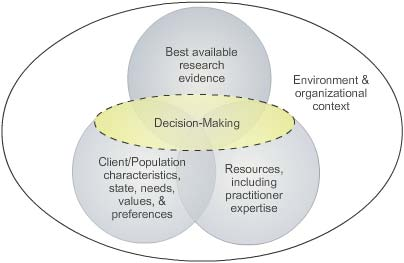
The three elements, or circles, of EBBP, are all influenced by the Environmental and Organizational Context. For shared decision to work, it is crucial that you convey information concerning treatment options clearly and appropriately with the client you are treating.
After explaining the treatment options very clearly, it's important to listen to client concerns, observe actions, adjust strategies, negotiate options, and consider available resources with the aim of achieving understanding and agreement on a course of action.
As you make decisions during the three scenarios in this course, you will need to weigh the pros and cons of the decisions available to you. You will be able to experience the outcomes of each decision, with different choices leading you down different paths and resulting in unique conclusions – both good and bad. You can replay each scenario as many times as you like to view the various possible outcomes.
Five Steps of Evidence-Based Practice
The EBBP process begins with an assessment of the client or community. It then proceeds, iteratively, through the following five steps:
- ASK relevant, answerable questions about the health status, context, and resources of the client or community
- ACQUIRE the best available evidence to answer the question.
- APPRAISE the evidence critically for validity and applicability to the problem at hand.
- APPLY the evidence by engaging in collaborative decision making with the affected client or groups – this is where the three circles of EBBP are put into practice.
- ANALYZE the effects of the new health program or treatment plan, and ADJUST practices accordingly.
Explanation
As you work through the three scenarios in this course, you will need to weigh the pros and cons of the decisions available to you. You will be able to experience the outcomes of each decision, with different choices leading you down different paths and resulting in unique consequences – both good and bad.
Once you have completed a scenario, you will view a assessment screen that shows how you balanced the three circles of EBBP or if your decisions favored certain circles over others.
Each scenario will begin with you, the clinician, having already conducted the first 3 steps in the EBBP Process. You will begin with the Apply stage, where you will be simulating working with actual clients, determining a course of action, and then analyzing and adjusting your practice as needed.
As mentioned earlier, the decisions you make will lead down different paths. You will notice as you begin a scenario that the Back button in the lower right corner is inactive. Just as in real life – there will be no Back button during these scenarios. However, you will be able to replay each scenario as many times as you like and view the various possible outcomes by using the decisional map. This map will become available once you complete a scenario.
Click on a client to begin the scenario, or if you have already completed a client scenario, click on 'View Decisional Map' at the bottom of the menu to replay the scenario and explore other possible outcomes.
Health Questionnaire Discussion
In this case, you will be playing the role of Dr. Phillip Logan. You’ve recently conducted an intake evaluation over the phone with a new patient, Douglas Patterson. You feel that Douglas might be suffering from moderate depression and review some literature on the condition to prepare for your first session with him.
When he arrives at your office for his first session, you decide to have him complete the nine-item Patient Health Questionnaire (PHQ -9) to further assess his depressive symptoms. Once he’s completed the questionnaire, you begin to discuss the results.
Clinician: You marked that you’ve had trouble sleeping, or maybe that you’re sleeping too much?
Douglas: (joking to avoid) It’s my favorite thing to do. (pause. reluctantly begins discussing the issue) But I don’t know. What’s too much? I am recovering from a pretty major surgery.
Clinician: How many hours a day would you say you spend sleeping, on average?
Douglas: Maybe ten or eleven.
Clinician: And you’ve been feeling depressed?
Douglas: A little, but I did just have a heart attack. My cardiologist thinks medication might help, but I’m taking enough pills already as it is. I’m just upset. I think that’s normal. My wife has had it up to here with me though.
Clinician: Why do you say that?
Douglas: She says (exhales)… She says I’ve been getting worse. That I’m always down about everything. She’s the one who suggested I come here. I didn’t want to, but hey (pause), if you can cheer me up about almost dying, then I’m all for it.
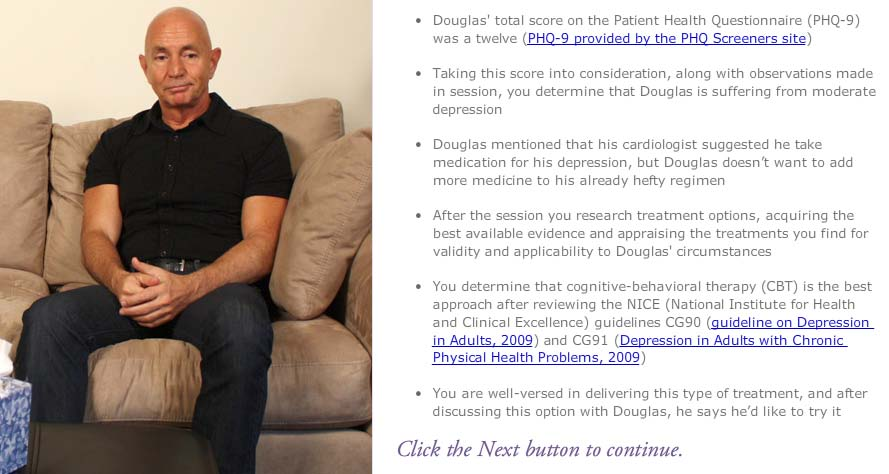
The Fourth Session
During Douglas’ fourth session, you conduct a brief symptom check and discover that he is beginning to show new symptoms of panic attacks and agoraphobia.
Clinician: So how have you been feeling?
Douglas: Better, I guess. My wife and daughter say they’ve noticed a difference, that I seem less down about things. I’ve been getting out of the house more, but…(hesitates)
Clinician: But?
Douglas: I get nervous, you know, or anxious, if I get too far from the house. I can't breathe and it feels like my heart is giving out again. It’s silly really, but it’s becoming more common.
Clinician: It isn’t silly. Can you tell me about a particular instance when you were anxious?
Douglas: Last weekend. My daughter wanted me to go to the lake with her and my grandkids, but that’s almost two hours away!
Clinician: And why do you think that makes you anxious?
Douglas: Well…I mean…what if we get all the way out there and my heart goes again? Or I’m taking a swim and something else inside me bursts?
Clinician: Your physician has told you that you’re in rather good health.
Douglas: Yeah, well, no offense to Dr. Lacher, but I had a major league chest-grabber under his watch.
Clinician: Didn’t you mention before that your job requires you to travel fairly often?
Douglas: Yeah. Which is a problem. I’ve been able to handle most of my sales calls over the phone so far, but pretty soon I’ll need to start making some in-person appointments. Thing is, I’m not sure I can.
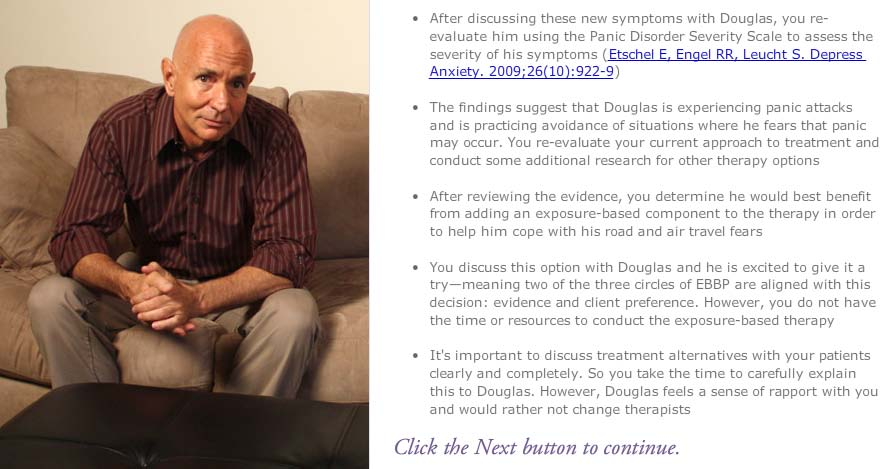
You do not have the time or resources to conduct the exposure-based therapy. You carefully explain this to Douglas, but he feels a sense of rapport with you and does not wish to see someone else at this time.
How would you like to proceed?
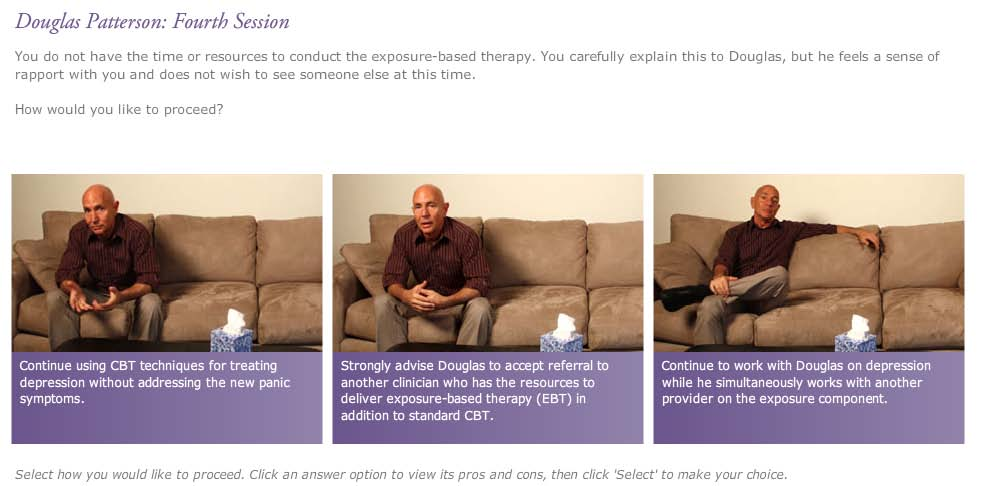
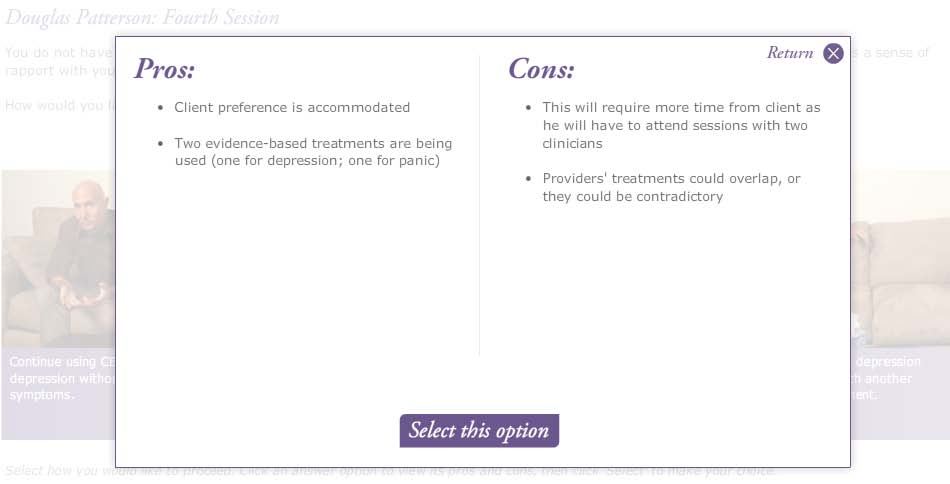
With this decision you aligned your approach with the client’s needs and with what was supported by the evidence. The choice accommodates your resources since you didn’t have adequate time to conduct exposure-based therapy.
However, seeing two clinicians will put more of a strain on Douglas’ resources as it will require more of his time and money to attend sessions with two clinicians.
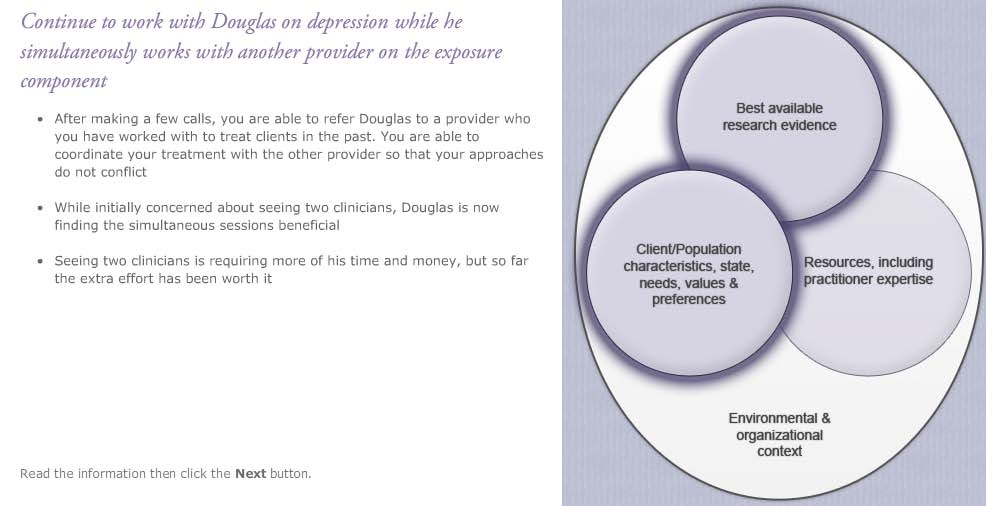
Sixth Session
Douglas returns for his sixth session. Overall, he has been happy with the blended approach to his therapy, but the travelling and cost associated with seeing two different clinicians is wearing on him.
Douglas: I mean neither one of you are exactly cheap—not that it hasn’t been worth it. But it would really help me out if we could come up with some other arrangement.
Clinician: You feel as though you’ve made some progress with the exposure therapy?
Douglas: Big time, but the travelling back and forth hasn’t been easy. Plus, sometimes I feel like she and I are covering things we’ve covered here – and vice versa.
Clinician: Perhaps we should look at having her manage your CBT as well as the exposure-based treatment.
Douglas: (jokingly) You trying to get rid of me?
Clinician: Not at all. However, you’ve said that you feel like she’s been helpful and I believe she is qualified to provide CBT.
Douglas: But you’re qualified to deliver both treatments too, right?
Clinician: I am, but it would be difficult for me to schedule the time to travel with you to administer the exposure therapy myself. If you feel comfortable with your other clinician--
Douglas: Look, she’s been great. But if I wanted to have her take over all of my sessions I’d be having this conversation with her.
Seeing two different clinicians has put a serious strain on Douglas’ resources.
He is happy with the blended treatment approach that is being implemented currently, but would like to receive both treatments from you.
How would you like to proceed?
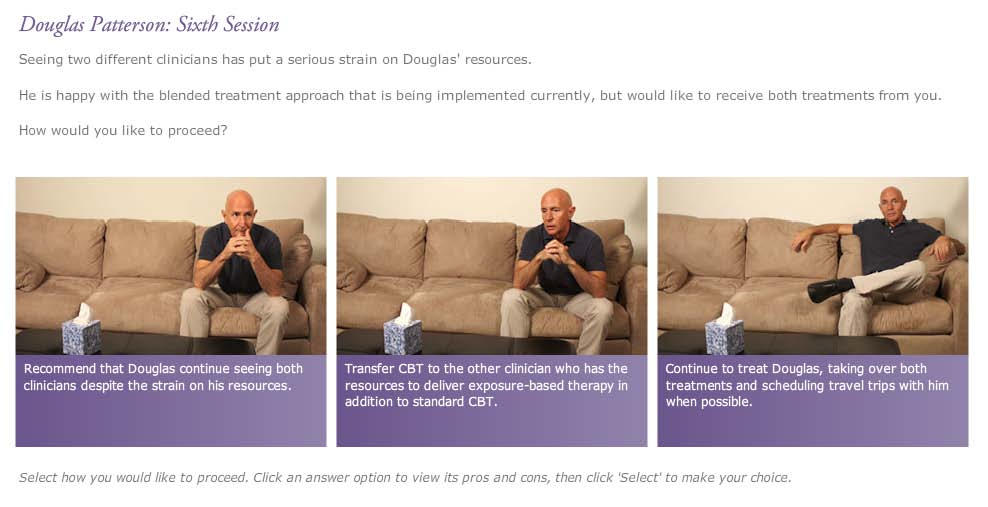
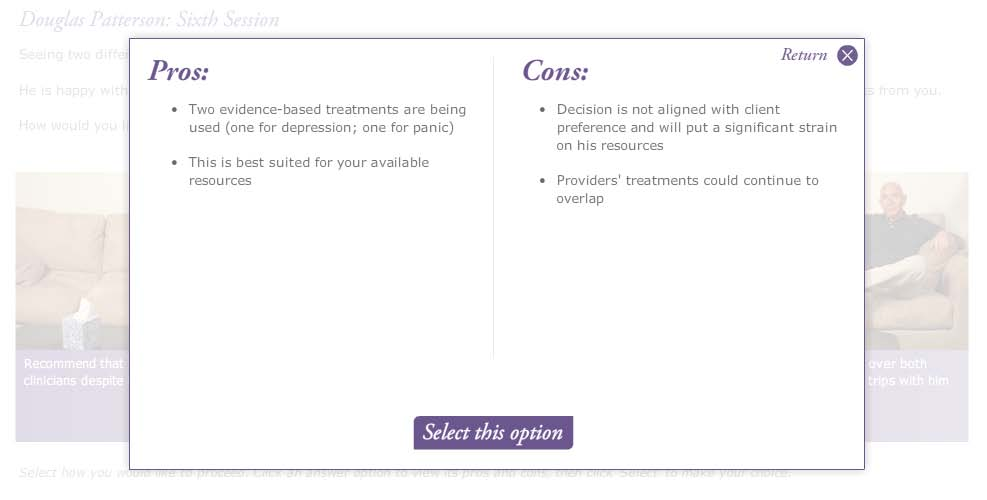
With this decision you prioritized an evidence-based approach that allowed for two evidence-based treatments to continue to be utilized. However, seeing two clinicians is putting a significant strain on the client’s resources.
Determining a Course of Action
Decision Map
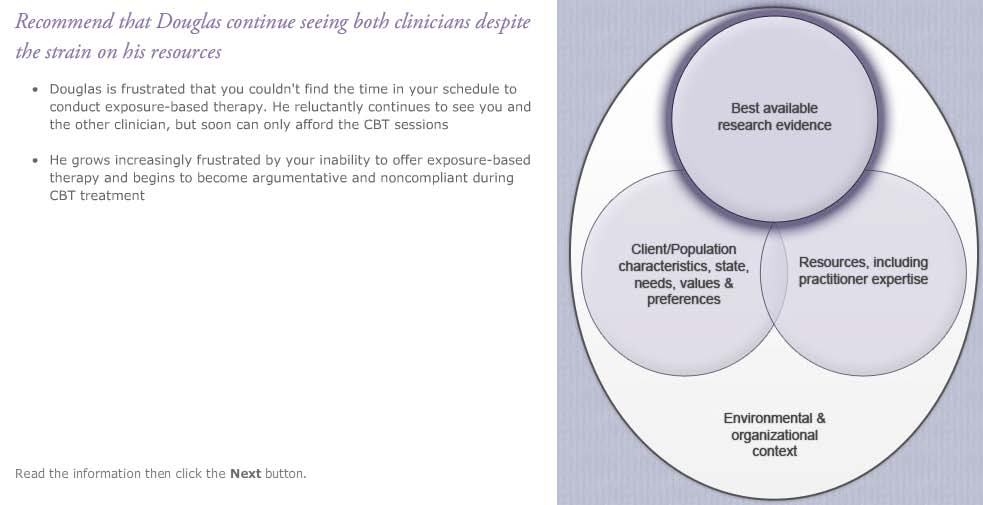
When determining a course of action to take with a client, the three elements, or circles, of EBBP must be taken into consideration. Let’s see how you did.
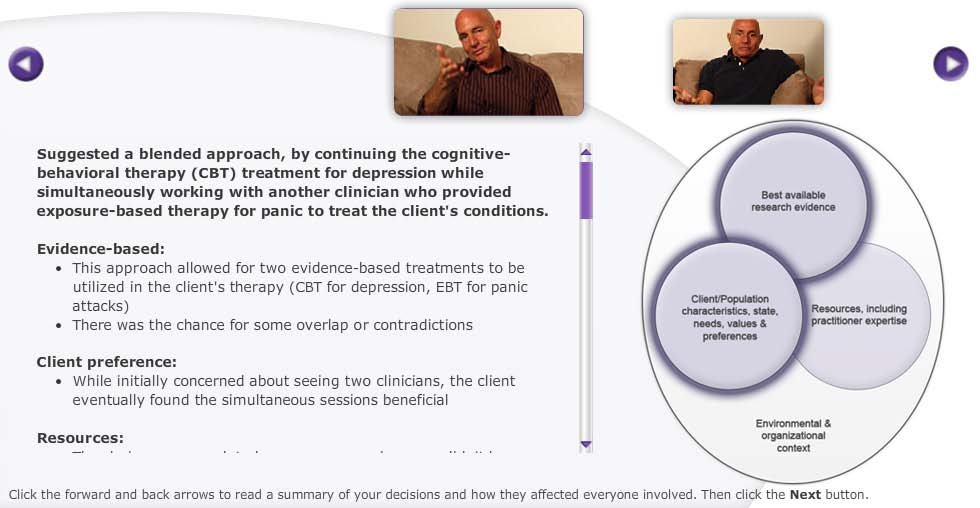
Here is a map showing the path you just completed based on your decisions. If you would like to go back to a specific decision point and explore another outcome, click the decision point on the map to return to that screen
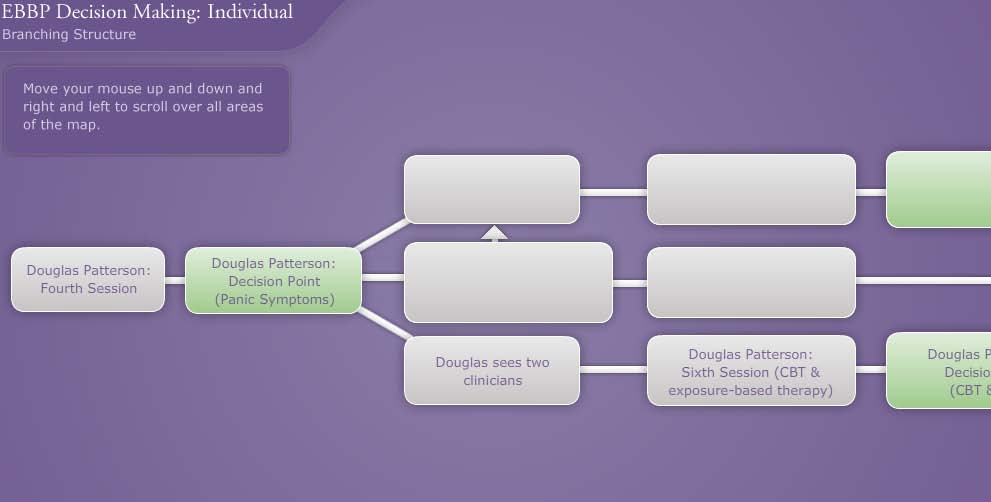
You can try the scenario again from the beginning by clicking the Next button to return to the main menu and selecting the patient again.